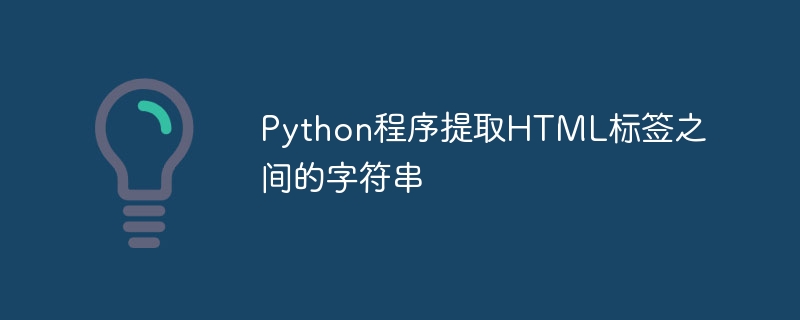
HTML标签用于设计网站的框架。我们通过在标签中包含的字符串形式传递信息和上传内容。HTML标签之间的字符串决定了元素在浏览器中的显示和解释方式。因此,提取这些字符串在数据操作和处理中起着至关重要的作用。我们可以分析和理解HTML文档的结构。
这些字符串揭示了构建网页背后的隐藏模式和逻辑。在本文中,我们将处理这些字符串。我们的任务是提取HTML标签之间的字符串。
理解问题
我们需要提取在HTML标记之间的所有字符串。我们的目标字符串被不同类型的标记包围,只有内容部分应该被检索出来。让我们通过一个例子来理解这个问题。
输入输出场景
让我们考虑一个字符串 -
Input: Inp_STR = "<h1>This is a test string,</h1><p>Let's code together</p>"
输入字符串由不同的HTML标签组成,我们需要提取它们之间的字符串。
Output: [" This is a test string, Let's code together "]
正如我们所看到的,"<h1>"和"<p>"标签被移除了,字符串被提取出来。现在我们已经理解了问题,让我们讨论一下几个解决方案。
使用迭代和替换()
这种方法专注于消除和替换HTML标签。我们将传递一个字符串和一个不同HTML标签的列表。之后,我们将将此字符串初始化为列表的一个元素。
我们将遍历标签列表中的每个元素,并检查它是否存在于原始字符串中。我们将传递一个“pos”变量,它将存储索引值并驱动迭代过程。
我们将使用“replace()”方法将每个标签替换为一个空格,并获取一个没有HTML标签的字符串。
Example
的中文翻译为:示例
以下是一个示例,用于提取HTML标签之间的字符串 -
Inp_STR = "<h1>This is a test string,</h1><p>Let's code together</p>"
tags = ["<h1>", "</h1>", "<p>", "</p>", "<b>", "</b>", "<br>"]
print(f"This is the original string: {Inp_STR}")
ExStr = [Inp_STR]
pos = 0
for tag in tags:
if tag in ExStr[pos]:
ExStr[pos] = ExStr[pos].replace(tag, " ")
pos += 1
print(f"The extracted string is : {ExStr}")
输出
This is the original string: <h1>This is a test string,</h1><p>Let's code together</p> The extracted string is : [" This is a test string, Let's code together "]
使用正则表达式模块 + findall()
在这种方法中,我们将使用正则表达式模块来匹配特定的模式。我们将传递一个正则表达式:“<"+tag+">(.*?)</"+tag+">”,该表达式表示目标模式。该模式旨在捕获开放和关闭标签。在这里,“tag”是一个变量,通过迭代从标签列表中获取其值。
“findall()”函数用于在原始字符串中找到模式的所有匹配项。我们将使用“extend()”方法将所有的“匹配项”添加到一个新的列表中。通过这种方式,我们将提取出HTML标签中包含的字符串。
Example
的中文翻译为:示例
以下是一个示例 -
import re
Inp_STR = "<h1>This is a test string,</h1><p>Let's code together</p>"
tags = ["h1", "p", "b", "br"]
print(f"This is the original string: {Inp_STR}")
ExStr = []
for tag in tags:
seq = "<"+tag+">(.*?)</"+tag+">"
matches = re.findall(seq, Inp_STR)
ExStr.extend(matches)
print(f"The extracted string is: {ExStr}")
输出
This is the original string: <h1>This is a test string,</h1><p>Let's code together</p> The extracted string is: ['This is a test string,', "Let's code together"]
使用迭代和find()函数
在这种方法中,我们将使用“find()”方法获取原始字符串中开放和关闭标签的第一个出现。我们将遍历标签列表中的每个元素,并检索其在字符串中的位置。
将使用While循环来继续在字符串中搜索HTML标签。我们将建立一个条件来检查字符串中是否存在不完整的标签。在每次迭代中,索引值将被更新以找到下一个开放和关闭标签的出现。
所有开放和关闭标签的索引值都被存储,一旦整个字符串被映射,我们使用字符串切片来提取HTML标签之间的字符串。
Example
的中文翻译为:示例
以下是一个示例 -
Inp_STR = "<h1>This is a test string,</h1><p>Let's code together</p>"
tags = ["h1", "p", "b", "br"]
ExStr = []
print(f"The original string is: {Inp_STR}")
for tag in tags:
tagpos1 = Inp_STR.find("<"+tag+">")
while tagpos1 != -1:
tagpos2 = Inp_STR.find("</"+tag+">", tagpos1)
if tagpos2 == -1:
break
ExStr.append(Inp_STR[tagpos1 + len(tag)+2: tagpos2])
tagpos1 = Inp_STR.find("<"+tag+">", tagpos2)
print(f"The extracted string is: {ExStr}")
输出
The original string is: <h1>This is a test string,</h1><p>Let's code together</p> The extracted string is: ['This is a test string,', "Let's code together"]
结论
在本文中,我们讨论了许多提取HTML标签之间字符串的方法。我们从更简单的解决方案开始,定位并替换标签为空格。我们还使用了正则表达式模块及其findall()函数来找到匹配的模式。我们还了解了find()方法和字符串切片的应用。



